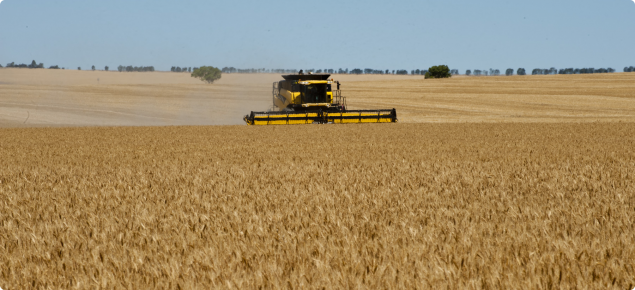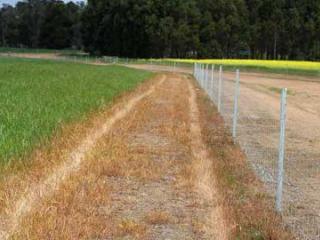Impeding weed importation and spread at critical points
Sowing of the seed
Weed seed is regularly spread around and between farms as a contaminant of seed retained for sowing. Seed for sowing is more often than not contaminated with weed seeds and frequently at very high levels. Check seed analysis before buying seed-lots.
Fencelines and non-cropped areas in cropping paddocks (for example, water courses)
Weed infestations often start in non-crop areas (for example, around buildings, along roadsides, along fencelines). Weeds in non-crop areas experience no crop competition and can produce large quantities of seed. Controlling these initial populations will prevent weeds from spreading to other parts of the property.
Machinery and vehicle usage
Strict vehicle hygiene (that is, regular cleaning) can reduce the risk of new infestations and weed spread.
Stock feed and livestock movement
New livestock, or those returning to the property from agistment, can carry weed seeds from other areas. Weeds can be easily imported from different regions or states because livestock can travel significant distances by road within a 24-hour period. Quarantine contaminated fodder in a sacrifice paddock or feedlot so weeds are contained in a small area.
Sow weed-free seed
Determining weed seed contamination levels
To estimate the number of weed seeds being introduced at sowing:
- Obtain a random one kilogram (kg) sample of the seed to be sown.
- Separate the foreign seed from the crop seed.
- Count each type of foreign seed, including weeds and volunteer crop seeds.
- Multiply the number of weed seeds of each species by the proposed crop sowing rate kilograms per hectare (kg/ha) This will give the number of weeds potentially sown per hectare of crop.
- To calculate the density of weeds per metre squared (m2), divide the weeds/ha by 10 000.
While the number may work out to be only small (perhaps 1-2 weeds/m2 or less), it is important to remember many weed species are prolific seed producers and a single plant growing in ideal conditions can contribute a large number of seeds to the seedbank.
Managing weeds in non-crop areas
Practices to control weeds around the farm
Many weeds are well-adapted to non-arable areas of the farm and thrive in stockyards, laneways, firebreaks around sheds and buildings and in tree plantings.
These non-arable areas are the home to an assortment of annual and perennial weeds and can create problems in many ways:
- They can be a source of weed seeds for the introduction to other areas of the farm.
- They can present a fire hazard.
- They can harbour vermin and insect pests and act as hosts for some plant diseases.
- They detract from the appearance of the farm.
Weed control around farm buildings
Controlling weeds around farm buildings is required by law to reduce a potential fire hazard. This can be achieved by regular mowing or herbicide application by knapsack sprayer or pressurised hand lead. Knockdown or residual herbicides (or a combination of the two) can be used depending on whether the weeds have emerged, the time of year and the weeds present.
Chemical firebreaks
These can replace or supplement mechanical methods. Advantages include the reduced risks of soil erosion, weed reinfestation and damage to fences by fire as well as providing greater flexibility and speed as show below (Figure 1).
Knockdown or residual herbicides (or a combination of both) can be used.
Weed control on roaded catchments
Weed growth can significantly reduce run-off by breaking up the surface seal and increasing infiltration and by holding a small part of each shower of rain. Weeds also reduce raindrop impact on the soil surface. Raindrop impact causes a crust to form on the soil surface which limits the rate of water infiltration into the soil. Most run-off occurs during winter, so early control of winter-growing annual weeds is important. Regular maintenance and regrading the catchment will control weeds. In between regrading however, apply appropriate (knockdown or residual) herbicides. Residual herbicides can be washed off compacted clay surfaces contaminating run-off water — the choice of herbicide is largely decided by the end-use of the water.
Water weed control in dams
Rising temperatures and falling water levels during summer often lead to the appearance of aquatic weeds. The most commonly-found species are floating pond weed, blunt pond weed, duck weed, red azolla and common milfoil. Before deciding whether to control weeds in dams, remember they may be beneficial and provide food and shelter for fish, other aquatic animals and birds. They might also use nutrients in the dam preventing nutrient enrichment that could lead to algal blooms. Aquatic weeds can be controlled by mechanical and/or chemical means. Mechanical methods such as cutting, mowing, dredging, drying and chaining may be effective but are short-lived. Chemical control must be undertaken with considerable care, considering the identity of the weed, the effect of herbicides on desirable plants, fish and other aquatic life and the eventual use of the water (irrigation, domestic purposes or stock). Take your water weed to your local agronomist or DPIRD office for correct identification and control advice.
Weed control for successful revegetation
Successful establishment of trees from seedlings depends on successful weed control. Weeds around trees compete with young seedlings, harbour pests and vermin (rabbits), cause spindly growth and present a fire hazard when dry.


